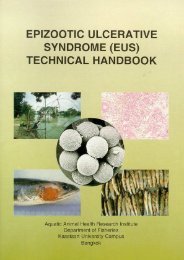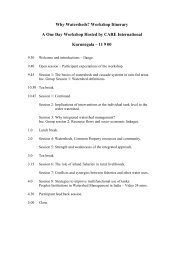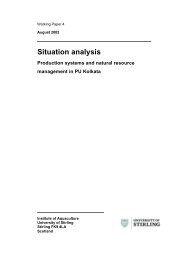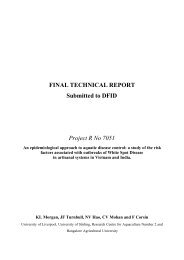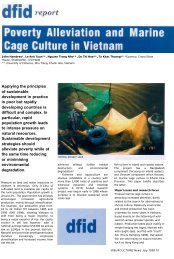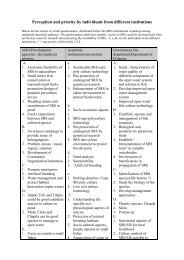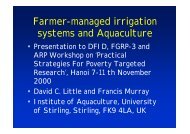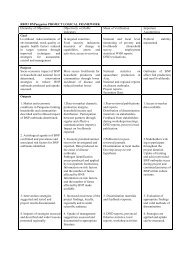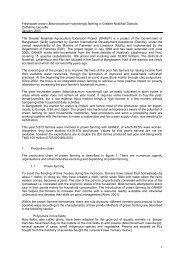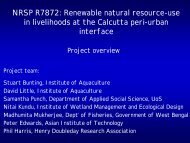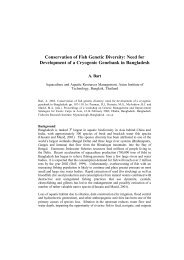(Cyprinus carpio) in Karnataka, India - Research for Development
(Cyprinus carpio) in Karnataka, India - Research for Development
(Cyprinus carpio) in Karnataka, India - Research for Development
You also want an ePaper? Increase the reach of your titles
YUMPU automatically turns print PDFs into web optimized ePapers that Google loves.
Genetic Status and Strategies <strong>for</strong> Improvement ofCommon Carp (<strong>Cypr<strong>in</strong>us</strong> <strong>carpio</strong>) <strong>in</strong> <strong>Karnataka</strong>, <strong>India</strong> -Evaluation of Stocks <strong>for</strong> the <strong>Development</strong> of aBreed<strong>in</strong>g ProgrammeY. Basavaraju 1 , D.J. Penman 2 and G.C. Mair 31 University of Agricultural Sciences, Fisheries <strong>Research</strong> Station,Hesaraghatta, Bangalore, <strong>India</strong>2 Institute of Aquaculture, University of Stirl<strong>in</strong>g, Stirl<strong>in</strong>g FK9 4LA,Scotland3 Asian Institute of Technology, Bangkok, ThailandBasavaraju, Y., Penman, D.J. and Mair, G.C. 2002. Genetic status and strategies <strong>for</strong>improvement of common carp (<strong>Cypr<strong>in</strong>us</strong> <strong>carpio</strong>) <strong>in</strong> <strong>Karnataka</strong>, <strong>India</strong> - evaluation of stocks <strong>for</strong>the development of a breed<strong>in</strong>g programme. pp. 29-36. In: Penman, D.J., Hussa<strong>in</strong>, M.G.,McAndrew, B.J. and Mazid, M.A. (eds.). Proceed<strong>in</strong>gs of a workshop on Ge netic Managementand Improvement Strategies <strong>for</strong> Exotic Carps <strong>in</strong> Bangladesh, 12-14 February 2002, Dhaka,Bangladesh. Bangladesh Fisheries <strong>Research</strong> Institute, Mymens<strong>in</strong>gh, Bangladesh. 123 p.AbstractThe importance of common carp (<strong>Cypr<strong>in</strong>us</strong> <strong>carpio</strong>) to aquaculture and enhancedfisheries <strong>in</strong> <strong>Karnataka</strong> state, southern <strong>India</strong> has steadily <strong>in</strong>creased s<strong>in</strong>ce its first<strong>in</strong>troduction. Accord<strong>in</strong>g to the most recently available statistics, common carp nowcontributes 43% of the seed stocked by the Department of Fisheries (Basavaraju etal., 2000). Precocious maturation and unwanted reproduction have been identified aspotential constra<strong>in</strong>ts on yields of common carp <strong>in</strong> aquaculture and culture-basedfisheries <strong>in</strong> <strong>Karnataka</strong> (Basavaraju et al., 2002). Both males and females can atta<strong>in</strong>sexual maturation well be<strong>for</strong>e reach<strong>in</strong>g a marketable size. Even if fish do not spawnand produce fry, the gonadosomal <strong>in</strong>dex (GSI) can exceed 20% of the harvestedweight of an <strong>in</strong>dividual fish. This early maturation poses a potential problem <strong>for</strong>culture, <strong>in</strong> that energy is likely to be diverted from somatic growth <strong>in</strong>to gonaddevelopment and reproduction, and fry and f<strong>in</strong>gerl<strong>in</strong>gs may compete with stockedfish <strong>for</strong> resources with<strong>in</strong> the culture system. Various options such as <strong>in</strong>duction oftriploidy, production of monosex populations and evaluation of different stocks were
Basavaraju, Y. et al.<strong>in</strong>vestigated under a research project funded by DFID FGRP, UK. The present paperdiscusses the results of the prelim<strong>in</strong>ary trials on evaluation of different stocks ofcommon carp, and future strategies planned <strong>for</strong> the genetic improvement of commoncarp stocks.IntroductionThe common carp (<strong>Cypr<strong>in</strong>us</strong> <strong>carpio</strong>) is an important species <strong>in</strong> aquaculture andenhanced fisheries <strong>in</strong> <strong>Karnataka</strong> state, southern <strong>India</strong>. It is grown either alone or <strong>in</strong>polyculture, most commonly with catla (Catla catla) and rohu (Labeo rohita ). Thecommon carp presently grown <strong>in</strong> <strong>Karnataka</strong> orig<strong>in</strong>ate from two <strong>in</strong>troductions to<strong>India</strong>, <strong>in</strong> 1939 (“German” stra<strong>in</strong>) and 1957 (“Bangkok” stra<strong>in</strong>) (Jh<strong>in</strong>gran, 1991).These have become mixed over many generations to give the current stock. Thisstock of common carp is characterised by early sexual maturation (at an age ofapproximately six months and sometimes at a weight below 100 g) and multiplespawn<strong>in</strong>g <strong>in</strong> a s<strong>in</strong>gle year. This early maturation poses a potential problem <strong>for</strong>culture, <strong>in</strong> that energy is likely to be diverted from somatic growth <strong>in</strong>to gonaddevelopment and reproduction, and fry and f<strong>in</strong>gerl<strong>in</strong>gs may compete with stockedfish <strong>for</strong> resources with<strong>in</strong> the culture system. Several local farmers, fisheries officialsand scientists have cited this as a problem <strong>in</strong> the culture of common carp <strong>in</strong> the state,although the extent of this problem has not been quantified. The problem is unlikelyto be as severe as that seen <strong>for</strong> tilapia but may neverthele ss have significant negativeimpacts on yields.The bulk of common carp seed production <strong>in</strong> <strong>Karnataka</strong> is by the State sector, withapproximately 30 State controlled hatcheries produc<strong>in</strong>g seed of this species. Whilstthere is a greater degree of gene flow <strong>in</strong> and out of some of these hatcheries thanexists <strong>for</strong> <strong>India</strong>n major carp stocks, most of these hatcheries nevertheless function asreproductively isolated units. Furthermore, hatchery managers are commonlyfocused on produc<strong>in</strong>g sufficient quantity of seed to atta<strong>in</strong> prescribed targets, withlittle if any consideration <strong>for</strong> the genetic quality of the stocks. Inbreed<strong>in</strong>g, negativeselection and genetic drift are likely to have occurred dur<strong>in</strong>g the long history ofdomestication of these stocks <strong>in</strong> such environments, although this is hard to verify(Basavaraju et al., 2000).There are a number of potential solutions to problems of early maturation:• Induce sterility by <strong>in</strong>duction of triploidy or through hormonal treatments• Produce monosex populations, which will not breed and may mature later (sexualmaturation is commonly delayed <strong>in</strong> fish <strong>in</strong> the absence of the opposite sex).30
Genetic improvement of common carp <strong>in</strong> <strong>Karnataka</strong>, <strong>India</strong>• Evaluate other stra<strong>in</strong>s of the species <strong>in</strong> the hope of identify<strong>in</strong>g later matur<strong>in</strong>gstra<strong>in</strong>s.The above options were <strong>in</strong>vestigated under research funded by DFID-AFGRP,UK.The present paper describes results of <strong>in</strong>itial growth trials on several stocks ofcommon carp and the development of a breed<strong>in</strong>g programme <strong>for</strong> this species <strong>in</strong><strong>Karnataka</strong>. Faster grow<strong>in</strong>g stocks of common carp may also mature later (at a largersize and/or greater age) and are likely to benefit those <strong>in</strong>volved <strong>in</strong> produc<strong>in</strong>g andconsum<strong>in</strong>g common carp as long as genetic improvement is carried out <strong>in</strong> anappropriate way (e.g. select<strong>in</strong>g <strong>for</strong> improved per<strong>for</strong>mance <strong>in</strong> low <strong>in</strong>put environmentsrather than <strong>in</strong>creased appetite).Identification and collection of different stocks of common carpA number of stocks of common carp from different geographical locations outside<strong>India</strong> were identified as hav<strong>in</strong>g potential <strong>for</strong> faster growth and delayed maturation.These were imported <strong>in</strong>to <strong>India</strong> follow<strong>in</strong>g appropriate quarant<strong>in</strong>e, etc. Two localstocks of common carp were also <strong>in</strong>cluded <strong>in</strong> the collections. These stocks are listed<strong>in</strong> Table 1.Table 1. List of common carp stocks held by the project component <strong>in</strong> <strong>India</strong> and theabbreviations used <strong>for</strong> them.Full Name Abbreviations SourceWild Amur Carp Amur HungaryP-3 (Selected L<strong>in</strong>e) P-3 HungarySelected Vietnamese SV VietnamUnselected Vietnamese UV VietnamRajadanu RJ IndonesianLocal stock (FRSH) L-FRSH Fisheries <strong>Research</strong> Station,HesaraghattaLocal stock (BRP) L-BRP BRP state hatcheryEvaluation of different stocks of common carp: trial IThe <strong>in</strong>itial growth trials were conducted with the first two imported stocks (SV andUV) and with one local stock of commo n carp <strong>in</strong> mono and polyculture systems. Foreach pond, f<strong>in</strong>gerl<strong>in</strong>gs of each stock were reared to a similar size be<strong>for</strong>e be<strong>in</strong>gcommunally stocked. Data is presented here from monoculture experimentsconducted on station (at FRSH) and polyculture growth trials conducted <strong>in</strong> a farmer’spond. The fish were marked us<strong>in</strong>g PIT tags. The results of two monoculture trials aresummarised <strong>in</strong> Tables 2 and 3, while those from the farmer’s pond are shown <strong>in</strong>31
Basavaraju, Y. et al.Tables 4 and 5. It is clear from these results and other trials (not shown here) that theper<strong>for</strong>mance of the SV was superior to L-FRSH and UV <strong>in</strong> that it exhibited fastergrowth rate and lower GSI (gonadosomatic <strong>in</strong>dex).Table 2. Stock<strong>in</strong>g details and mean weight (g) atta<strong>in</strong>ed by different stocks of common carp <strong>in</strong>monoculture at f<strong>in</strong>al harvest (after 36 weeks of rear<strong>in</strong>g). Means with<strong>in</strong> a column with differentletter superscripts are significantly different from each other (P
Genetic improvement of common carp <strong>in</strong> <strong>Karnataka</strong>, <strong>India</strong>Table 4. Stock<strong>in</strong>g details and mean weight (g) atta<strong>in</strong>ed by SV and L-FRSH stocks of commoncarp <strong>in</strong> polyculture at harvest <strong>in</strong> on farm trial, Amareshwara camp. Means with<strong>in</strong> a columnwith different letter superscripts are significantly different from each other (P
Basavaraju, Y. et al.100Survival rate (%)806040L-FRSHL-BRPSVP-3AmurMean weight ga<strong>in</strong> (g)500400300200L-FRSHL-BRPSVP-3Amur201000FRSH Poly FRSH Mono FRSH Sep BRP Poly0FRSH Poly FRSH Mono FRSH Sep BRP PolyLocation of trialLocation of trial15100008000L-FRSHL-BRPSVP-3Amur10L-FRSHL-BRPSVP-3AmurYield (kg)6000GSI (%)4000520000FRSH Poly FRSH Mono FRSH Sep BRP Poly0FRSH Poly FRSH Mono FRSH Sep BRP PolyLocation of trialLocation of trialFigure 2. Histograms show<strong>in</strong>g the relative culture per<strong>for</strong>mance (survival, mean weight ga<strong>in</strong>,yield and GSI) of five stra<strong>in</strong>s of common carp cultured <strong>in</strong> four different on-stationenvironments. Environments are (from left to right <strong>in</strong> each histogram) FRSH-Polyculture,FRSH-Monoculture, FRSH-Monoculture (separate stock<strong>in</strong>g) and BRP-Polyculture (see alsoTable 6).It is clear from these results that the Amur stra<strong>in</strong> <strong>in</strong>troduced from Hungary is superior<strong>for</strong> the majority of traits. The other Hungarian stra<strong>in</strong> (P3) showed the highestsurvival rate dur<strong>in</strong>g the trial. Interest<strong>in</strong>gly, the SV stra<strong>in</strong>, although per<strong>for</strong>m<strong>in</strong>grelatively poorly <strong>for</strong> most traits, was the best <strong>for</strong> reproduction-rela ted traits (GSI anddressout).34
Genetic improvement of common carp <strong>in</strong> <strong>Karnataka</strong>, <strong>India</strong>Table 7. Mean rank of different stocks <strong>for</strong> a range of traits across four culture systems(highlighted cells <strong>in</strong>dicate highest rank<strong>in</strong>g stock <strong>for</strong> each trait).Trait Amur P-3 SV L-BRP L-FRSHSurvival 2.13 1.63 4.88 2.88 3.50Weight Ga<strong>in</strong> 1.25 2.25 3.50 3.25 4.75Harvest Weight 1.25 2.25 3.50 3.25 4.75Gutted Weight 1.25 2.75 3.00 3.00 5.00Yield 1.25 2.00 4.00 3.25 4.50Gutted Yield 1.25 2.25 3.50 3.25 4.75GSI (%) 2.50 2.50 4.75 2.25 3.00Dressout (%) 3.00 4.00 1.25 3.25 3.50Se<strong>in</strong>ability 2.13 2.75 2.75 3.63 3.75Evaluation of different stocks of common carp and F1 crosses between stocksThe current series of trials focuses on completion of the evaluation of the differentstocks and on evaluation of F1 crosses between the better per<strong>for</strong>m<strong>in</strong>g stocks todeterm<strong>in</strong>e if heterosis (superiority of crosses over parental stocks) is found andshould be taken <strong>in</strong>to account <strong>in</strong> future breed<strong>in</strong>g plans. The L-FRSH and UV stockshave been dropped from this series of trials, but the most recent import, the RJ stock,has been added, mak<strong>in</strong>g a total of five (Amur, P-3, SV, L-BRP and RJ). We arecurrently runn<strong>in</strong>g one trial compar<strong>in</strong>g pure stocks and one conta<strong>in</strong><strong>in</strong>g a mixture of F1and pure parental stocks. Rank<strong>in</strong>g of mean weights from the on-station pondsapproximately three months after stock<strong>in</strong>g gives the follow<strong>in</strong>g overall rank order <strong>for</strong>the first of these (pure stocks): RJ > Amur > L-BRP > SV. The same analysis <strong>for</strong> thesecond trial (pure stocks and crossbreds) gives: Amur > L-BRP*Amur > L-BRP = L-BRP*SV > SV. This data is very prelim<strong>in</strong>ary, but does appear to suggest consistencyof stock rank<strong>in</strong>g between the two trials (not surpris<strong>in</strong>g given that they came from thesame breed<strong>in</strong>g sets) and an absence of heterosis <strong>in</strong> the crossbreds at this stage.Future activitiesThe current series of trials will be completed <strong>in</strong> 2003, allow<strong>in</strong>g us to determ<strong>in</strong>e whichstocks and/or crosses are best <strong>for</strong> conditions <strong>in</strong> <strong>Karnataka</strong>. Heterosis has beenobserved <strong>in</strong> crosses between different stocks of common carp <strong>in</strong> other situations, andif large may be worth utilis<strong>in</strong>g. The exact nature of the breed<strong>in</strong>g plan will bedeterm<strong>in</strong>ed by the outcome of the current trials. For example, <strong>in</strong> the absence ofsignificant heterosis, this may consist of a selective breed<strong>in</strong>g programme based on asynthetic base population developed from the best stocks.35
Basavaraju, Y. et al.A socioeconomic survey is under progress to study the present status of carpaquaculture <strong>in</strong> <strong>Karnataka</strong> and also the perception of farmers and those <strong>in</strong>volved <strong>in</strong>development of fisheries and aquaculture <strong>in</strong> the state. The survey will also provide<strong>in</strong><strong>for</strong>mation on the type and socioeconomic status of the farmers. Participatorystudies are also expected to help us to prioritise traits <strong>for</strong> selection.Cryopreservation will be used to set up a sperm gene bank from the founder stocks:this can be used <strong>in</strong> the future to replace any unexpected losses and to evaluateprogress through selective breed<strong>in</strong>g (eggs from a future generation of carp can besplit and fertilised by milt from the future generation and milt from the base stock:comparison of the per<strong>for</strong>mance of the two groups should give us a measure of half ofthe genetic ga<strong>in</strong>). Monosex female production is also be<strong>in</strong>g evaluated and may be<strong>in</strong>corporated <strong>in</strong>to breed<strong>in</strong>g plans.ReferencesJh<strong>in</strong>gran, V.G., 1991. Fish and Fisheries of <strong>India</strong>. 2 nd Ed., H<strong>in</strong>dustan Publish<strong>in</strong>gCorporation, New Delhi. 727p.Basavaraju, Y., Mair, G.C. and Penman, D.J. 2000. Proceed<strong>in</strong>g of the secondworkshop on Genetic Improvement of Carps. 14-16 February, 2000. UAS,Bangalore, 79p.Basava raju, Y., Mair, G.C., Mohan Kumar, H.M., Pradeep Kumar, S., Keshavappa,G.Y. and Penman, D.J. 2002. An evaluation of triploidy as a potentialsolution to the problem of precocious sexual maturation <strong>in</strong> common carp,<strong>Cypr<strong>in</strong>us</strong> <strong>carpio</strong>, <strong>in</strong> <strong>Karnataka</strong>, <strong>India</strong>. Aqua culture 204:407-418.36




